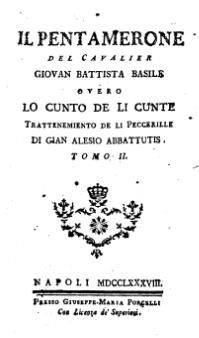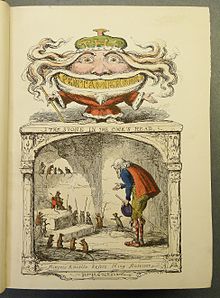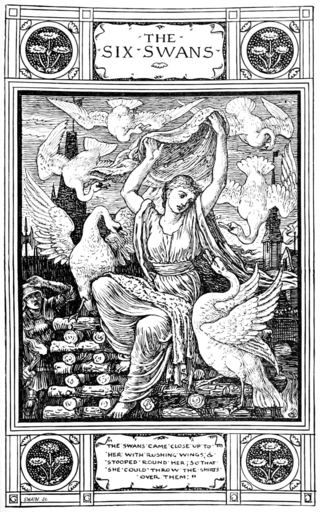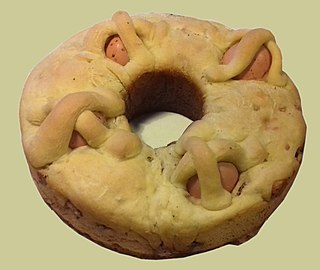
The Pentamerone, subtitled Lo cunto de li cunti ("The Tale of Tales"), is a seventeenth-century Neapolitan fairy tale collection by Italian poet and courtier Giambattista Basile.

The Pentamerone, subtitled Lo cunto de li cunti ("The Tale of Tales"), is a seventeenth-century Neapolitan fairy tale collection by Italian poet and courtier Giambattista Basile.
The stories in the Pentamerone were collected by Basile and published posthumously in two volumes by his sister Adriana in Naples, Italy, in 1634 and 1636 under the pseudonym Gian Alesio Abbatutis. These stories were later adapted by Charles Perrault and the Brothers Grimm, the latter making extensive, acknowledged use of Basile's collection. Examples of this are versions of Cinderella, Rapunzel, Puss in Boots, Sleeping Beauty, and Hansel and Gretel.
While other collections of stories have included stories that would be termed fairy tales, his work is the first collection in which all the stories fit in that single category. [1] He did not transcribe them from the oral tradition as a modern collector would, instead writing them in Neapolitan, and in many respects was the first writer to preserve oral intonations. [2]
The style of the stories is heavily Baroque, with many metaphorical usages. [3]
This has been interpreted as a satire on Baroque style, but as Basile praised the style, and used it in his other works, it appears to have no ironic intention. [4]

Although the work fell into obscurity, the Brothers Grimm, in their third edition of Grimm's Fairy Tales , praised it highly as the first national collection of fairy tales, fitting their romantic nationalist views on fairy tales, and as capturing the Neapolitan voice. This drew a great deal of attention to the work. [5]
This collection (Basile's Pentamerone) was for a long time the best and richest that had been found by any nation. Not only were the traditions at that time more complete in themselves, but the author had a special talent for collecting them, and besides that an intimate knowledge of the dialect. The stories are told with hardly any break, and the tone, at least in the Neapolitan tales, is perfectly caught.... We may therefore look on this collection of fifty tales as the basis of many others; for although it was not so in actual fact, and was indeed not known beyond the country in which it appeared, and was never translated into French, it still has all the importance of a basis, owing to the coherence of its traditions. Two-thirds of them are, so far as their principal incidents are concerned, to be found in Germany, and are current there at this very day. Basile has not allowed himself to make any alteration, scarcely even any addition of importance, and that gives his work a special value – Wilhelm Grimm
Basile's writing inspired Matteo Garrone's 2015 film, The Tale of Tales . [6]
The tales of Giambattista Basile are set in Basilicata and Campania, where he spent most of his life at the local nobles. Among the places related to the stories we find the city of Acerenza and the Castle of Lagopesole, the latter connected to the fairy tale Rapunzel.
The name of the Pentamerone comes from Greek πέντε [pénte], 'five', and ἡμέρα [hêméra], 'day'. It is structured around a fantastic frame story, in which fifty stories are related over the course of five days, in analogy with the ten-day structure of the much earlier Decameron by Giovanni Boccaccio (1353). The frame story is that of a cursed, melancholy princess named Zoza ("mud" or "slime" in Neapolitan, but also used as a term of endearment). She cannot laugh, no matter what her father does to amuse her, so he sets up a fountain of oil by the door, thinking people slipping in the oil would make her laugh. An old woman tried to gather oil, a page boy broke her jug, and the old woman grew so angry that she danced about, and Zoza laughed at her. The old woman cursed her to marry only the prince of Round-Field, whom she could only wake by filling a pitcher with tears in three days. With some aid from fairies, who also give her gifts, Zoza found the prince and the pitcher, and nearly filled the pitcher when she fell asleep. A Moorish slave steals it, finishes filling it, and claims the prince.
This frame story in itself is a fairy tale, [7] combining motifs that will appear in other stories: the princess who cannot laugh in The Magic Swan , Golden Goose , and The Princess Who Never Smiled ; the curse to marry only one hard-to-find person, in Snow-White-Fire-Red and Anthousa, Xanthousa, Chrisomalousa ; and the heroine falling asleep while trying to save the hero, and then losing him because of trickery in The Sleeping Prince and Nourie Hadig .
The now-pregnant slave-princess demands (at the impetus of Zoza's fairy gifts) that her husband tell her stories, or else she would crush the unborn child. The husband hires ten female storytellers to keep her amused; disguised among them is Zoza. Each tells five stories, most of which are more suitable to courtly, rather than juvenile, audiences. The Moorish woman's treachery is revealed in the final story (related, suitably, by Zoza), and she is buried, pregnant, up to her neck in the ground and left to die. Zoza and the Prince live happily ever after.
Many of these fairy tales are the oldest known variants in existence. [8]
The fairy tales are:
The text was translated into German by Felix Liebrecht in 1846, into English by John Edward Taylor in 1847 and again by Sir Richard Francis Burton in 1893 and into Italian by Benedetto Croce in 1925. Another English translation was made from Croce's version by Norman N. Penzer in 1934. A new, modern translation by Nancy L. Canepa was published in 2007 by Wayne State University Press, and was later released as a Penguin Classics paperback in 2016.
The 2015 Italian film Tale of Tales , directed by Matteo Garrone, is generally based on stories from the collection, starring Salma Hayek, Vincent Cassel and Toby Jones as protagonists of the tales "The Enchanted Doe", "The Flayed Old Lady" and "The Flea", respectively. [6]

"Cinderella", or "The Little Glass Slipper", is a folk tale with thousands of variants that are told throughout the world. The protagonist is a young girl living in forsaken circumstances that are suddenly changed to remarkable fortune, with her ascension to the throne via marriage. The story of Rhodopis, recounted by the Greek geographer Strabo sometime between 7 BC and 23 AD, about a Greek slave girl who marries the king of Egypt, is usually considered to be the earliest known variant of the Cinderella story.

"Sleeping Beauty", also titled in English as The Sleeping Beauty in the Woods, is a fairy tale about a princess cursed by an evil fairy to sleep for a hundred years before being awakened by a handsome prince. A good fairy, knowing the princess would be frightened if alone when she wakes, uses her wand to put every living person and animal in the palace and forest asleep, to awaken when the princess does.
This article contains information about the literary events and publications of 1634.

"Rapunzel" is a German fairy tale most notably recorded by the Brothers Grimm and published in 1812 as part of Children's and Household Tales. The Brothers Grimm's story was developed from the French literary fairy tale of Persinette by Charlotte-Rose de Caumont de La Force (1698), which itself is an alternative version of the Italian fairy tale Petrosinella by Giambattista Basile.

Giambattista Basile was an Italian poet, courtier, and fairy tale collector. His collections include the oldest recorded forms of many well-known European fairy tales. He is chiefly remembered for writing the collection of Neapolitan fairy tales known as Il Pentamerone.
Fairytale fantasy is distinguished from other subgenres of fantasy by the works' heavy use of motifs, and often plots, from folklore.

"The Six Swans" is a German fairy tale collected by the Brothers Grimm in Grimm's Fairy Tales in 1812. It is of Aarne–Thompson type 451, commonly found throughout Europe. Other tales of this type include The Seven Ravens, The Twelve Wild Ducks, Udea and her Seven Brothers, The Wild Swans, and The Twelve Brothers. Andrew Lang included a variant of the tale in The Yellow Fairy Book.

"Petrosinella" is a Neapolitan literary fairy tale, written by Giambattista Basile in his collection of fairy tales in 1634, Lo cunto de li cunti, or Pentamerone.
"The Four Skillful Brothers" is a German fairy tale collected by the Brothers Grimm. It is Aarne-Thompson type 653.

The Princess Who Never Smiled, The Unsmiling Tsarevna or The Tsarevna who Would not Laugh is a Russian folk fairy tale collected by Alexander Afanasyev in Narodnye russkie skazki, as tale number 297.
The Flea is an Italian literary fairy tale written by Giambattista Basile in his 1634 work, the Pentamerone. It combines Aarne-Thompson-Uther types 857, "The Louse-Skin" and ATU 653, "The Four Skillful Brothers".
Pintosmalto or Pinto Smauto is an Italian literary fairy tale written by Giambattista Basile in his 1634 work, the Pentamerone.
Sapia Liccarda is an Italian literary fairy tale written by Giambattista Basile in his 1634 work, the Pentamerone. It is not known whether he had a specific source, either literary or oral, for this tale.
The Dove is an Italian literary fairy tale written by Giambattista Basile in his 1634 work, the Pentamerone.
The Three Crowns is an Italian literary fairy tale written by Giambattista Basile in his 1634 work, the Pentamerone.

The Facetious Nights of Straparola, also known as The Nights of Straparola, is a two-volume collection of 75 stories by Italian author and fairy-tale collector Giovanni Francesco Straparola. Modeled after Boccaccio's Decameron, it is significant as often being called the first European storybook to contain fairy-tales; it would influence later fairy-tale authors like Charles Perrault and Jacob and Wilhelm Grimm.
The Dragon is an Italian literary fairy tale, included in Giambattista Basile's Pentamerone, first published 1635. In the English language, the tale was a selection in Thomas Keightley's Fairy Mythology (1828), and later appeared in John Edward Taylor 's translation of the entire work, The Pentamerone, or, The Story of Stories, Fun for the Little Ones (1848). The tale has been classed as a version of Aarne–Thompson type 462 "the outcast queens and the ogress queen", rather than as "the dragon-slayer". It exhibits folklore motif K873, "fatal deception by giving narcotic."
The Golden Root or The Golden Trunk is a literary fairy tale written by Giambattista Basile in the Pentamerone, as the fourth story of the fifth day. It is considered to be one of two rewritings of the Graeco-Roman myth of "Cupid and Psyche" by Basile, the other being "Lo Catenaccio".

Casatiello is a leavened savory bread originating from Naples prepared during the Easter period.
A literary fairy tale is a fairy tale that differs from an oral folktale in that it is written by "a single identifiable author", as defined by Jens Tismar's monograph. They also differ from oral folktakes, which can be characterized as "simple and anonymous", and exist in a mutable and difficult to define genre with a close relationship to oral tradition.